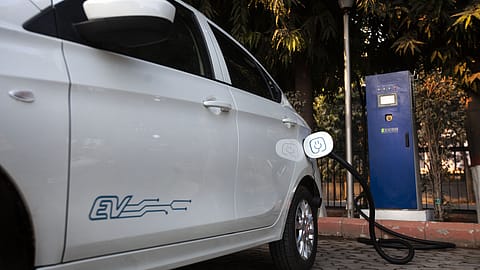Powering India’s electric future: The role of battery components and ESG in EV manufacturing
Improvements in LiB technology and eco-friendly manufacturing processes are the key to making India energy independent and lowering its carbon emissions.

Electric vehicles (EVs) conjure images of quick charging, low maintenance, and fresh air. However, most people are unaware that the lithium-ion battery (LiB), which makes up over 40% of an electric vehicle's cost, is what makes all of this feasible. Not only do these batteries drive our future means of transportation, but they are also components of energy storage systems, such as all the batteries in modern phones.
Improvements in LiB technology and eco-friendly manufacturing processes are the key to making India energy independent and lowering its carbon emissions. LiBs were responsible for 60% of global lithium, 30% of cobalt, and 10% of nickel requirements in 2022. What does this mean? This means supply chain security and sustainability will be key problems that nations like India with limited reserves will have to solve. India can solve this challenge by shifting its focus on battery technology innovation instead. By investing in advanced battery technologies that use minimal critical minerals, have high efficiency and performance. Alongside this it will also have to manufacture vehicles that support these optimized batteries and develop a recycling system for used batteries.
Lithium-ion cells are made up of cathode, anode, separator and an electrolyte, with cathode and the anode together representing over 50% of the cost. For cathodes, battery chemistries such as Lithium Iron Phosphate (LFP) instead of the more popular Nickel Manganese Cobalt Oxide (NMC) batteries could be used. NMCs use cobalt as well as nickel, whereas LFP batteries consist of iron and phosphorus; these are decidedly more abundant along with possessing a greatly longer life cycle. Encouragement of LFP technology can lower production costs and reliance on several rare minerals quite a bit.
The anode, the other essential element of LiBs, is also experiencing revolutionary change. Silicon-doped graphite anodes, which substitute some or all of the graphite with silicon, have already hit the market, providing increased energy density and reduced weight. Currently, approximately 30% of anodes are silicon-composites, and further developments, including lithium metal anodes, hold out the prospect of even higher energy density in the future making them suitable for mass-market adoption.
These advancements are not just improving battery efficiency but also reducing costs. Pack manufacturing costs, according to research, will reduce by 20% by 2025, and cell production costs will reduce by 10% from their record low in 2021. Such cost savings are vital to making EVs affordable and available to the general public, tackling a major concern about the price parity of EVs vehicles compared to Internal Combustion Engine (ICE) vehicles.
The government of India has made substantial efforts to support the local EV and battery manufacturing ecosystem. In the most recent move, the Union Budget 2025 eradicated basic customs duty on the import of several essential materials. This includes lead, zinc, and cobalt, it also removed BCD on certain capital goods which are used in EV production.
The government has also introduced an ₹18,100 crore Production Linked Incentive (PLI) scheme for Advanced Chemistry Cell (ACC). This aims to set up 50 GWh of production capacity by FY27. Combined with the National Manufacturing Mission (also announced in the budget), which will focus on clean tech production, India is expected to increase domestic capability in EV batteries, motors, controllers, and grid-scale power storage.
Recommended Stories
Although most companies have announced their EV centric programs we are still dependent on imports for battery materials such as cathodes and anodes. With China leading this list and being the world's largest producer. But with special policies and incentives, India wants to bring down this dependence on imported batteries to about 20% by FY27. Schemes like the PM E-Drive which give incentives to buyers of EVs and developers of charging infrastructure, will lay the groundwork for this in terms of demand and scalability.
If India wants to achieve its net zero target by 2070 a checkpoint will be to create secure and stable supply chains for raw materials like lithium and develop a strong domestic battery recycling infrastructure.This involves long-term trade deals with resource-abundant countries in Latin America or Australia. While, recycling will decrease dependence on imported virgin material by focusing on recovering minerals and mitigate environmental issues related to resource extraction and disposal.
In the last ten years, LiB technology has progressed significantly with issues of cost, range limitation, and safety issues being actively addressed. The prices of batteries have come down from $780/kWh in 2013 to $78/kWh in 2024 by technical improvements, volume economies, and reducing raw materials costs alone. Bundled with various government initiatives such as the Faster Adoption and Manufacturing of Electric Vehicles (FAME) and Viability Gap Funding (VGF) for Battery Energy Storage Systems (BESS) we can fast-track EV adoption.
As India ramps up its battery and component production capabilities, incorporating ESG principles in this process is not negotiable. The global drive towards achieving net-zero carbon emissions has created a topmost priority for sustainability, and the EV sector cannot afford to take a back seat. ESG-oriented policies are capable of providing solutions to the issues of resource extraction, high-energy production processes, and battery recycling, which will ensure the shift to e-mobility does not come with new pollution issues.This involves cleaner production practices, minimizing carbon footprints, and encouraging fair labor practices in the supply chain.
(INR CR)
Through the integration of ESG principles into the EV production process, India can move forward on its net-zero objectives with fewer moving parts, build a circular economy, and create a sustainable future. By adopting ESG values, the EV sector can make this transition not only economically feasible but also sustainable and socially just.